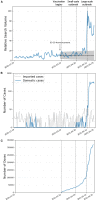Utilizing Internet Search Volume to Monitor Stages of Change in Vaccine Hesitancy During the COVID-19 Outbreaks
- PMID: 35859768
- PMCID: PMC9289155
- DOI: 10.3389/fpubh.2022.844543
Utilizing Internet Search Volume to Monitor Stages of Change in Vaccine Hesitancy During the COVID-19 Outbreaks
Abstract
Real-time vaccine hesitancy surveillance is needed to better understand changes in vaccination behaviors. We aim to understand the association between coronavirus disease 2019 (COVID-19) outbreaks and population vaccine hesitancy and to monitor the dynamic changes in vaccination behaviors. We used the autoregressive integrated moving average model to examine the association between daily internet search volume for vaccines and two waves of COVID-19 local outbreaks in Taiwan from 19 March to 25 May, 2021. During the small-scale outbreak, the search volume increased significantly for 7 out of 22 days with an average increase of 17.3% ± 10.7% from the expected search volume. During the large-scale outbreak, the search volume increased significantly for 14 out of 14 days, with an average increase of 58.4% ± 14.7%. There was a high correlation between the search volume and the number of domestic cases (r = 0.71, P < 0.001). Google Trends serves as a timely indicator to monitor the extent of population vaccine willingness.
Keywords: COVID-19; Google Trends; stages of change; vaccine hesitancy; vaccine willingness.
Copyright © 2022 Lan, Wu and Lin.
Conflict of interest statement
The authors declare that the research was conducted in the absence of any commercial or financial relationships that could be construed as a potential conflict of interest.
Figures

Similar articles
-
Utilizing Google trends to monitor coronavirus vaccine interest and hesitancies.Vaccine. 2022 Jun 26;40(30):4057-4063. doi: 10.1016/j.vaccine.2022.05.070. Epub 2022 May 30. Vaccine. 2022. PMID: 35660035 Free PMC article.
-
Changes in Parental Attitudes Toward COVID-19 Vaccination and Routine Childhood Vaccination During the COVID-19 Pandemic: Repeated Cross-sectional Survey Study.JMIR Public Health Surveill. 2022 May 13;8(5):e33235. doi: 10.2196/33235. JMIR Public Health Surveill. 2022. PMID: 35486516 Free PMC article.
-
Potential Determinants Contributing to COVID-19 Vaccine Acceptance and Hesitancy in Taiwan: Rapid Qualitative Mixed Methods Study.JMIR Form Res. 2023 Sep 12;7:e41364. doi: 10.2196/41364. JMIR Form Res. 2023. PMID: 37698904 Free PMC article.
-
The impact of the web and social networks on vaccination. New challenges and opportunities offered to fight against vaccine hesitancy.Med Mal Infect. 2016 May;46(3):117-22. doi: 10.1016/j.medmal.2016.02.002. Epub 2016 Mar 14. Med Mal Infect. 2016. PMID: 26987960 Review.
-
What factors promote vaccine hesitancy or acceptance during pandemics? A systematic review and thematic analysis.Health Promot Int. 2022 Feb 17;37(1):daab105. doi: 10.1093/heapro/daab105. Health Promot Int. 2022. PMID: 34244738
References
Publication types
MeSH terms
Substances
LinkOut - more resources
Full Text Sources
Medical

